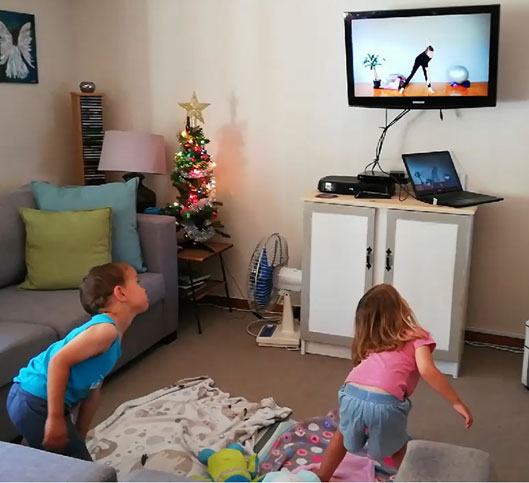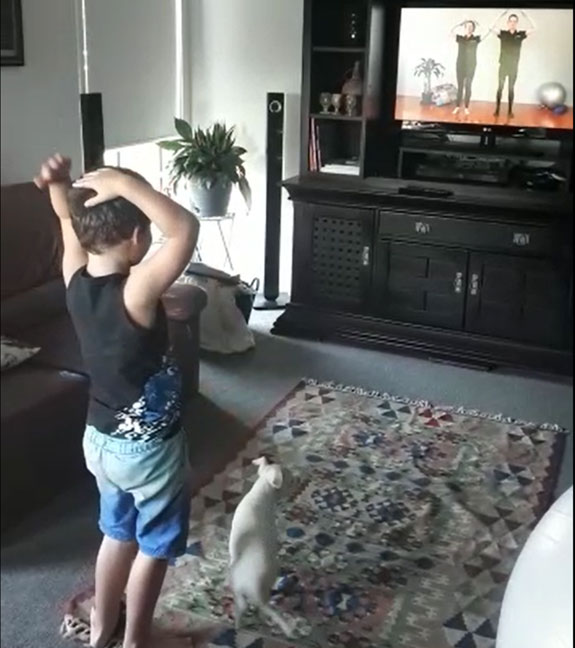ADHD & Attention Deficits, Autism
The Impact of Video-Based Exercises on Children with ADHD and Autism: Enhanced Engagement and Participation
- Introduction
1.1 Background:
Attention deficit hyperactivity disorder (ADHD) and autism spectrum disorder (ASD) are neurodevelopmental disorders affecting many children worldwide. Children with ADHD often exhibit difficulties sustaining attention, impulsivity, and hyperactivity, while children with ASD display challenges in social communication, restricted interests, and repetitive behaviours. These conditions can significantly impact their ability to engage in traditional instructional methods, leading to frustration, decreased motivation, and limited learning outcomes.
1.2 Objective:
This article aims to explore why children with ADHD and Autism find it easier to follow videos and participate in exercises when they are demonstrated on-screen. By investigating the underlying mechanisms and benefits associated with video-based exercises, this article aims to provide insights into how educators, therapists, and parents can optimise exercise environments to enhance learning experiences for children with ADHD, Autism and learning difficulties.
- The Challenges of Traditional Instructional Methods
2.1 ADHD and Autism: Common Characteristics:
While ADHD and Autism are distinct disorders, overlapping characteristics contribute to similar challenges in traditional instructional settings. Both conditions can result in difficulties with attention, processing sensory information, social interaction, and executive functioning. These challenges often lead to reduced engagement, increased distractibility, and difficulties following verbal exercises or demonstrations.

2.2 Limitations of Traditional Teaching Approaches:
Traditional instructional methods, such as lectures or written exercises, heavily rely on verbal communication and may lack the visual support and interactive elements necessary to engage children with attention deficit hyperactivity disorder and autism spectrum disorder effectively. The static and abstract nature of traditional teaching can hinder these children’s comprehension, retention, and active participation.
2.3 Need for Alternative Exercise Strategies:
Given the limitations of traditional approaches, there is a growing recognition of the need for alternative exercise strategies that cater to the unique learning profiles of children with ADHD, Autism and learning difficulties. Video-based exercises have emerged as a promising approach, leveraging visual, auditory, and interactive elements to enhance learning outcomes for these children.

- Video-Based Exercises: Theoretical Basis
3.1 Visual Learning and Attentional Mechanisms:
Video-based exercises capitalise on the visual learning style of children with attention deficit hyperactivity disorder and autism spectrum disorder. Visual stimuli can capture and sustain attention more effectively than purely auditory information, as visual cues provide a structured and engaging format that supports attentional focus and information processing.
3.2 Visual Support and Information Processing:
Visual supports in video-based exercises, such as clear demonstrations, step-by-step visuals, and visual cues, can facilitate information processing and comprehension for children with ADHD and Autism. These visual supports provide a concrete representation of the content, making it easier for these children to understand and follow exercises.
3.3 Mirror Neurons and Imitation:
Mirror neurons, a class of neurons in the brain, play a significant role in imitation and observational learning. Video-based exercises allow children to observe and imitate the actions, behaviours, and skills demonstrated on-screen. By activating mirror neurons, videos provide a powerful tool for children with attention deficit hyperactivity disorder and autism spectrum disorder to learn and acquire new skills.
3.4 Multimodal Learning and Engagement:
Video-based exercises like those you find in the CoordiKids Home Course incorporate multimodal elements, combining visuals, auditory cues, and interactive components. This multimodal approach enhances engagement by providing a dynamic and immersive learning experience, catering to the sensory needs and preferences of children with ADHD and Autism.
- Benefits of CoordiKids Video-Based Exercises for Children with attention deficit hyperactivity disorder and autism spectrum disorder and learning Difficulties
4.1 Increased Attention and Focus:
Videos capture and maintain children’s attention by offering visually stimulating and engaging content. The dynamic nature of videos, coupled with visual supports and interactive elements, helps sustain attention and focus, resulting in improved learning outcomes.

4.2 Enhanced Comprehension and Retention:
The visual and multimodal nature of video-based exercises enhances comprehension and retention of information for children with ADHD and Autism. By providing concrete and explicit demonstrations, videos enable these children to understand better and remember concepts and exercises.
4.3 Facilitated Imitation and Skill Acquisition:
Videos are powerful tools for facilitating imitation and skill acquisition in children with attention deficit hyperactivity disorder and autism spectrum disorder. By visually presenting the actions and behaviours to be imitated, videos provide a clear model that can be readily followed and practised, enhancing the acquisition of new skills.
4.4 Improved Engagement and Motivation:
Video-based exercises often elicit higher levels of engagement and motivation than traditional methods for children with ADHD and Autism. The dynamic and interactive nature of videos taps into their intrinsic motivation, making the learning process more enjoyable and rewarding.
4.5 Reducing Anxiety and Sensory Overload:
Traditional instruction methods may overwhelm children with ADHD and Autism due to sensory overload or anxiety. Video-based exercises allow for controlled sensory input, providing a predictable, structured learning environment that reduces anxiety and supports optimal learning conditions.
- Practical Implications and Recommendations
5.1 Designing Effective Video-Based Exercises Materials:
To optimise the effectiveness of video-based exercise, the CoordiKids OTs considered factors such as clear and concise demonstrations, visual supports, age-appropriate content, pacing, and interactive features. They designed materials that cater to the specific needs and preferences of children with attention deficit hyperactivity disorder and autism spectrum disorder to enhance their engagement and learning outcomes.

5.2 Integrating Video-Based Exercise into Educational Settings:
Educators and therapists can integrate video-based exercise into classroom settings, therapy sessions, or home-based interventions. By incorporating videos as a supplementary or primary teaching tool, they can provide children with ADHD and Autism with accessible and engaging learning experiences.
5.3 Collaborative Efforts: Teachers, Therapists, and Parents:
Successful implementation of video-based exercises requires collaborative efforts among teachers, therapists, and parents. Open communication and coordination ensure consistency across different learning environments and help tailor exercise strategies to the individual needs of children with attention deficit hyperactivity disorder and autism spectrum disorder.
5.4 Individualizing Exercise Approaches:
Recognising the heterogeneity within the ADHD and Autism populations, it is crucial to individualise exercise approaches. This includes considering the child’s developmental level, cognitive abilities, interests, and learning style. Flexibility in adapting video-based exercises to meet individual needs can optimise learning outcomes.
- Conclusion
6.1 Summary of Findings:
Video-based exercise offers significant advantages for children with ADHD and Autism, addressing the challenges they face in traditional learning methods. The visual nature, multimodal components, and the ability to facilitate attention, comprehension, imitation, engagement, and motivation make videos effective for supporting learning.
6.2 Importance of Video-Based Exercise in Educational Practices:
Understanding why children with attention deficit hyperactivity disorder and autism spectrum disorder find it easier to follow videos and participate in exercises demonstrated on-screen is crucial for educators, therapists, and parents. By harnessing the benefits of video-based exercise and incorporating it into educational practices, we can optimise learning environments and enhance educational outcomes for children with ADHD and Autism.

thanks for info